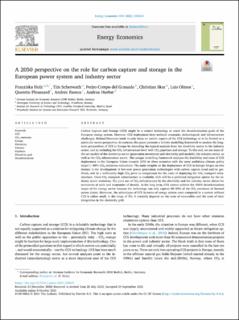| dc.contributor.author | Holz, Franziska | |
| dc.contributor.author | Scherwath, Tim | |
| dc.contributor.author | Crespo del Granado, Pedro | |
| dc.contributor.author | Skar, Christian | |
| dc.contributor.author | Olmos, Luis | |
| dc.contributor.author | Ploussard, Quentin | |
| dc.contributor.author | Ramos, Andrés | |
| dc.contributor.author | Herbst, Andrea | |
| dc.date.accessioned | 2022-01-26T13:41:50Z | |
| dc.date.available | 2022-01-26T13:41:50Z | |
| dc.date.created | 2021-11-25T08:59:35Z | |
| dc.date.issued | 2021 | |
| dc.identifier.citation | Energy Economics. 2021, 104, . | en_US |
| dc.identifier.issn | 0140-9883 | |
| dc.identifier.uri | https://hdl.handle.net/11250/2839491 | |
| dc.description.abstract | Carbon Capture and Storage (CCS) might be a central technology to reach the decarbonisation goals of the European energy system. However, CCS deployment faces multiple economic, technological, and infrastructure challenges. Related literature tends to only focus on certain aspects of the CCS technology or to be limited to a particular sector perspective. In contrast, this paper presents a holistic modelling framework to analyse the long-term perspectives of CCS in Europe by extending the typical analysis from the electricity sector to the industry sector, and by including the CO2 infrastructure level with CO2 pipelines and storage. To this end, we use state-of-the-art models of the electricity sector (generation investment and electricity grid models), the industry sector, as well as the CO2 infrastructure sector. This unique modelling framework analyses the feasibility and costs of CCS deployment in the European Union towards 2050 in three scenarios with the same ambitious climate policy target (~85% CO2 emissions reduction). The main insights on the deployment of CCS in Europe hinges on two factors: i) the development of low-cost power generation technologies with carbon capture (coal and/or gas-fired), and ii) a sufficiently high CO2 price to compensate for the costs of deploying the CO2 transport infrastructure. Once CO2 transport infrastructure is available, CCS will be a preferred mitigation option for the industry sector emissions. The joint use of CO2 infrastructure by the electricity and the industry sector allows for economies of scale and economies of density. In the long term, CCS cannot achieve the 100% decarbonisation target of the energy sector because the technology can only capture 80–90% of the CO2 emissions of thermal power plants. Moreover, the advantages of CCS in terms of energy system costs compared to a system without CCS is rather small, in the range of 2%. It crucially depends on the costs of renewables and the costs of their integration in the electricity grid. | en_US |
| dc.language.iso | eng | en_US |
| dc.publisher | Elsevier Science | en_US |
| dc.rights | Navngivelse 4.0 Internasjonal | * |
| dc.rights.uri | http://creativecommons.org/licenses/by/4.0/deed.no | * |
| dc.title | A 2050 perspective on the role for carbon capture and storage in the European power system and industry sector | en_US |
| dc.type | Peer reviewed | en_US |
| dc.type | Journal article | en_US |
| dc.description.version | publishedVersion | en_US |
| dc.source.volume | 104 | en_US |
| dc.source.journal | Energy Economics | en_US |
| dc.identifier.doi | 10.1016/j.eneco.2021.105631 | |
| dc.identifier.cristin | 1958776 | |
| dc.relation.project | Norges forskningsråd: 296205 | en_US |
| dc.source.articlenumber | 105631 | en_US |
| cristin.ispublished | true | |
| cristin.fulltext | original | |
| cristin.qualitycode | 1 | |

